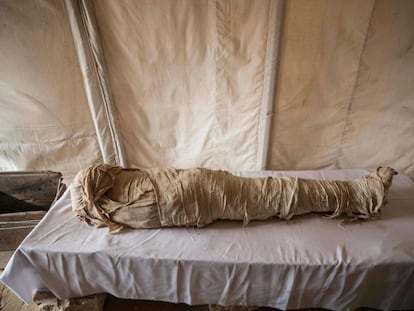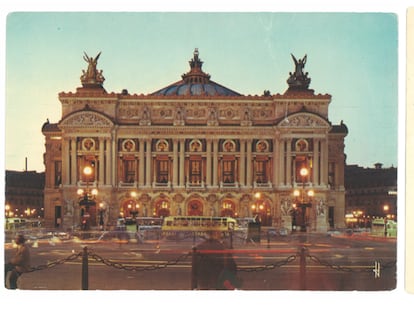The giant Byzantine mosaic hidden beneath an olive grove in Gaza
Efforts are underway to preserve the 1,500-year-old tilework that a Palestinian found near his home in a refugee camp
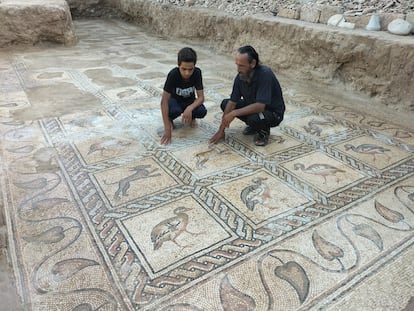

Salman al Nabahin wondered why one of the olive trees near his home in the Al Bureij refugee camp (Palestinian territory of Gaza) wasn’t growing well. He thought it might be the soil and decided to dig out all the rocks disturbing the roots. As he and his son Ahmed began digging, Ahmed hit something hard. “I thought it was just a floor tile, but I immediately saw the colors and liked them,” said the teenager about that day in March 2022. Father and son slowly dug away week after week while a nephew researched the discovery on the internet. Although he knew nothing about art, Al Nabahin sensed he had chanced upon something exceptional on his property. It was a Byzantine mosaic of at least sixty multi-colored panels decorated with the simple aesthetics of the time. The panels bore motifs of domesticated animals (dogs, horses, hares, ducks) and wild ones (felines, birds of prey, flamingos). Some were adorned with leafy vines and fruit.
“I don’t know what each one symbolizes, but when I saw the bird images, I realized it was wonderful,” said Al Nabahin as he stood next to the two large pits excavated between olive, fig, guava and palm trees. The mosaic is buried about three feet (one meter) below the surface and may extend as far as 5,400 square feet (500 square meters).
The part of the mosaic unearthed last summer looks exquisite. “The state of conservation is exceptional,” says Anthony Dutemple, head of Première Urgence Internationale’s mission to the occupied Palestinian territories. Local technicians from the French emergency aid organization conducted the first evaluation of the mosaic under the technical supervision of archaeologists from the French School of Biblical and Archeological Research in Jerusalem. Only a few parts of the mosaic suffered damage from “some ancient destruction, the passage of time and tree roots,” says Dutemple.
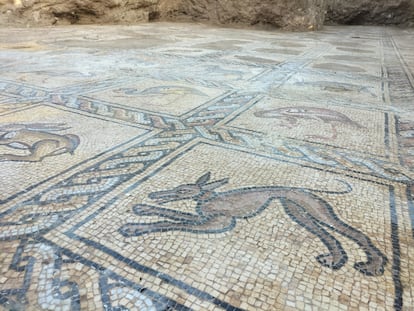
When Al Nabahin reported the discovery to the local authorities, his prior internet research led him to think that the mosaic dated from when the Roman Empire spread to the East and West. At the time, Gaza was known for its prosperity, as Pompey had rebuilt the area in the first century BC. Only later did he learn that it dated back to Byzantine times. “Analysis of the patterns and geometry indicates that the site could date from the 5th to 7th centuries… but it is not possible to date it precisely or fully understand its artistic and historical significance because it has not been thoroughly excavated archaeologically and was discovered by chance,” stated the Ramallah office of UNESCO.
The mosaic is a contemporary of the Monastery of St. Hilarion, also located in Gaza. The local port was commercially prominent in Byzantine times due to the wine it exported throughout the Mediterranean. At the end of the 4th century, regional authorities began to destroy the pagan temples and build churches. Three years later, after the Muslim general Amr ibn al-As conquered the area, the population converted to Islam, and Gaza’s Christian churches were gradually abandoned.
Jean-Baptiste Humbert leads the French School of Biblical and Archeological Research’s archaeological project in Gaza. He says he has an “intuition” that the mosaic belongs to one of the 16 monasteries that may have once existed in Gaza when it became a sanctuary for Monophysite Christians who believed that Jesus Christ’s nature remains altogether divine and not human even though he took on human form. “It [the mosaic] is very large and located in a rural area, far from the city. Two factors point in that direction [to the monophysites],” he says. Humbert, an elderly Dominican monk who has lived for 53 years in the Holy Land, rules out the theory that the mosaic adorned an aristocrat’s home since “in the Byzantine world, mosaics were found in churches instead of homes.” The other factor, said Dutemple, is that “calcareous stone was used for the white, red, pink, orange and brown pieces. Marble was used for the gray and blue pieces, and clay for some bright red ones. The yellows and greens came from vitreous material.”
At first, Al Nabahin tried to keep his discovery quiet, which is difficult in one of the world’s most densely populated territories. Word spread when one of his brothers found out. He says looters soon showed up at his house and offered him money for it. He turned them down despite living in an Israeli-controlled territory where 50% of the people live in poverty, according to the World Bank. “I was happy to have found something historical from our ancestors, which belongs to the entire Palestinian nation,” he says quietly. Al Nabahin has eight children and receives 1,500 shekels ($435) per month from Ramallah (the de facto administrative capital of the State of Palestine) as a Palestinian National Authority security forces member. Now he gets paid for doing nothing because the Islamist Hamas movement seized control of the Gaza strip in 2007. Al Nabahin supplements his salary with other income from his chickens and goats. His humble house is about half a mile (less than one kilometer) from the border fence with Israel, which can be easily seen in the distance.
The family is negotiating with the Hamas government in Gaza to exchange their property for another piece of fertile land, but an agreement has yet to be reached. Time favors the Al Nabahin family. Their excavation obviously did not follow scientific protocols, and the one conducted by the French organization “was mainly aimed at identifying the site’s boundaries” so that the authorities would have “an idea of how much private property they had to acquire and give in exchange,” said the Ramallah office of UNESCO.
When UNESCO staff visited the mosaic in September 2022, they posted a warning on Facebook that the site required “urgent intervention with a view to its conservation,” especially with winter approaching. Two months later, heavy rains flooded the excavated areas of the mosaic, which was minimally protected by canvas tarpaulins. After the flooding, the excavated sites were cleaned and covered with geotextile and sand, with bags of earth on all sides. UNESCO and Première Urgence Internationale then developed a more permanent conservation agreement signed on January 10. “The site will remain like this until April when the rains are over. I hope we can then find a more definitive solution,” said Dutemple.
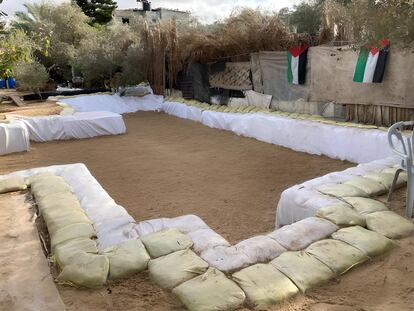
The conservation agreement may come to naught since it was signed with the Gaza Ministry of Antiquities, and the United Nations cannot endorse agreements with the de facto Hamas government. Dutemple says that the current deal is funded by the British Council Cultural Protection Fund and will pay for 14 young Palestinians to work on the site’s conservation as part of a program that seeks to bring together local heritage protection, humanitarian aid, psychosocial support and vocational training in a territory where at least half the population is unemployed.
Uniting to safeguard the recently discovered mosaics of Al-Bureij in #Gaza🤝👇🇵🇸
— UNESCO Ramallah (@UNESCO_Ramallah) January 10, 2023
In coordination with the Ministry of Tourism and Antiquities, UNESCO & @premiereurgence have established a partnership to provide urgent protection and safeguarding for the mosaics. pic.twitter.com/uMgcFoPjKq
Sign up for our weekly newsletter to get more English-language news coverage from EL PAÍS USA Edition
Tu suscripción se está usando en otro dispositivo
¿Quieres añadir otro usuario a tu suscripción?
Si continúas leyendo en este dispositivo, no se podrá leer en el otro.
FlechaTu suscripción se está usando en otro dispositivo y solo puedes acceder a EL PAÍS desde un dispositivo a la vez.
Si quieres compartir tu cuenta, cambia tu suscripción a la modalidad Premium, así podrás añadir otro usuario. Cada uno accederá con su propia cuenta de email, lo que os permitirá personalizar vuestra experiencia en EL PAÍS.
¿Tienes una suscripción de empresa? Accede aquí para contratar más cuentas.
En el caso de no saber quién está usando tu cuenta, te recomendamos cambiar tu contraseña aquí.
Si decides continuar compartiendo tu cuenta, este mensaje se mostrará en tu dispositivo y en el de la otra persona que está usando tu cuenta de forma indefinida, afectando a tu experiencia de lectura. Puedes consultar aquí los términos y condiciones de la suscripción digital.
More information
Últimas noticias
The story of the Málaga virus: The code that haunted Google’s cybersecurity center director for 30 years
The impact of Ecuador’s mega-prison: A polluted river, cleared forests and military checkpoints
Corinne Low: ‘I’m more concerned about the female happiness gap than the gender wage gap’
Trump traveled on Epstein’s plane ‘many more times’ than previously thought, according to new documents
Most viewed
- The low-cost creative revolution: How technology is making art accessible to everyone
- Christian Louboutin: ‘Young people don’t want to be like their parents. And if their parents wear sneakers, they’re going to look for something else’
- All the effects of gentrification in one corner of Mexico’s Colonia Roma
- Liset Menéndez de la Prida, neuroscientist: ‘It’s not normal to constantly seek pleasure; it’s important to be bored, to be calm’
- Christmas loses its festive spirit: ICE fears cast shadow over religious celebrations
